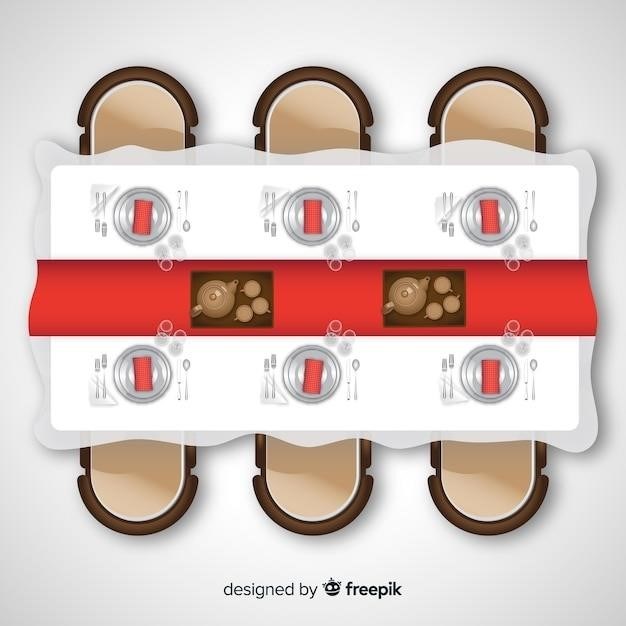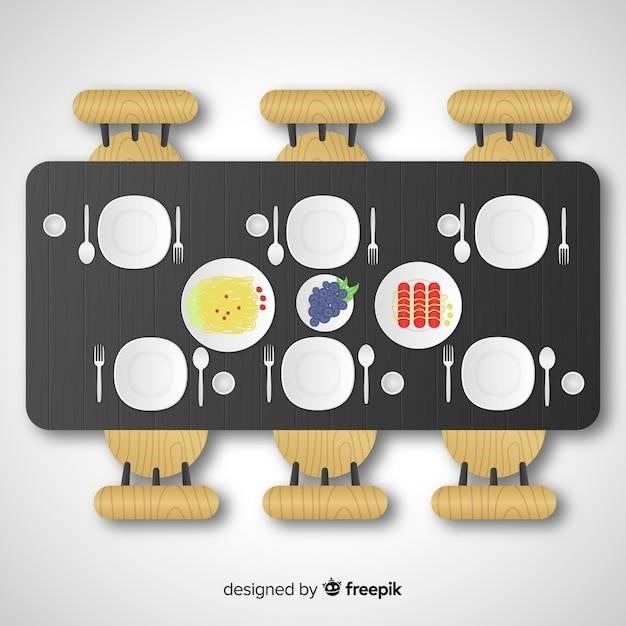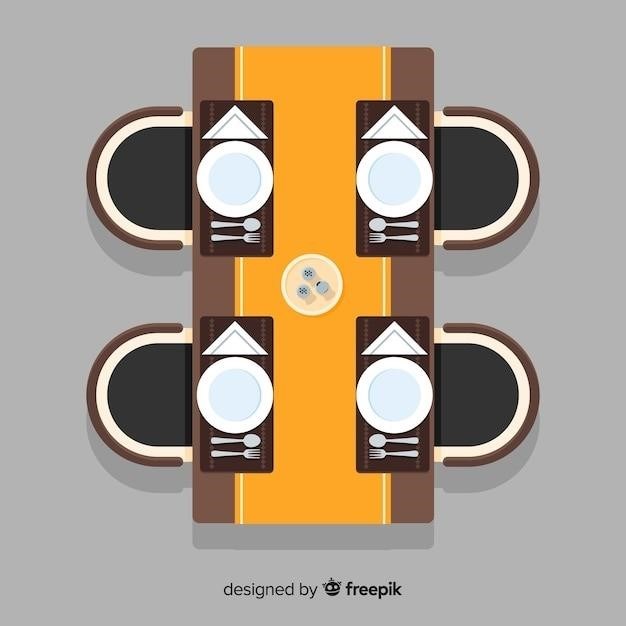Extendable dining table plans in PDF format provide comprehensive instructions, materials lists, and detailed diagrams for constructing a table that can expand to accommodate more guests․ These plans are often available online from woodworking websites and magazines, offering DIY enthusiasts a chance to create their own custom dining tables․
Introduction
Extendable dining tables are a versatile and practical solution for homes that need to accommodate varying numbers of guests․ These tables offer the flexibility to expand when entertaining a large crowd and retract to a more compact size for everyday use․ Building an extendable dining table from scratch can be a rewarding and cost-effective project, allowing you to create a custom piece that perfectly complements your dining space․
Extendable dining table plans in PDF format provide a comprehensive guide to the construction process․ These plans typically include detailed instructions, materials lists, cut lists, and diagrams, making it easier for DIY enthusiasts to follow along․ They often feature step-by-step instructions with clear illustrations, ensuring that even those with limited woodworking experience can build a sturdy and functional table․
The availability of free and paid extendable dining table plans online makes this project accessible to a wide range of individuals․ Whether you are a seasoned woodworker or a beginner eager to try a new project, these plans offer a valuable resource for creating a custom dining table that meets your specific needs and style preferences․
Types of Extendable Dining Tables
Extendable dining tables come in a variety of styles and mechanisms, each with its own advantages and disadvantages․ Understanding these different types will help you choose the best option for your needs and preferences․
One common type is the butterfly leaf table․ This design features leaves that fold in half and are stored underneath the tabletop when not in use․ The leaves are typically attached to a slide mechanism that allows them to be easily pulled out and locked in place․ This type of table is popular for its compact size and ease of use․

Another option is the drop-leaf table․ These tables have leaves that can be raised and lowered, usually attached to hinges or brackets․ The leaves can be stored against the sides of the table when not needed, making them suitable for smaller spaces․
Trestle tables are known for their sturdy construction and often incorporate extendable features․ They typically have a wide tabletop supported by two trestle legs, with leaves that can be inserted between the table halves․
The extension slide table is a more complex design that involves a set of slides that support the leaves as they are pulled out and locked in place․ This type of table often has a more substantial construction and is ideal for larger gatherings․
Materials and Tools
The materials and tools required for building an extendable dining table will vary depending on the specific design and plan you choose․ However, some common materials and tools include⁚
Wood⁚ Hardwoods like oak, maple, cherry, or walnut are popular choices for dining tables due to their durability and aesthetic appeal․ Softwoods like pine or fir can also be used, but they may require more care and maintenance․
Fasteners⁚ Wood screws, bolts, dowels, and glue will be necessary to secure the various components of the table․
Hardware⁚ This includes items like extension slides, hinges, leaf supports, and locking mechanisms․
Finishing materials⁚ Wood stain, paint, varnish, and sealer will be needed to protect the table and enhance its appearance․
Tools⁚ Essential tools for building an extendable dining table include⁚
* Circular saw or table saw
- Jigsaw
- Drill
- Sander
- Router
- Clamps
- Measuring tape
- Level
- Pencil
- Safety glasses
- Dust mask

It’s essential to read the specific plan you’re following carefully to gather all the necessary materials and tools before you begin․
Design Considerations
When working with extendable dining table plans, several design considerations will influence the final outcome and functionality of your table․ These considerations include⁚
Size and Shape⁚ Determine the desired size and shape of your table, considering the available space in your dining area and the number of people you want to accommodate․
Extension Mechanism⁚ Choose an extension mechanism that suits your needs and preferences․ Options include butterfly leaves, self-storing leaves, or sliding leaves․ Consider the ease of use, storage space required, and the desired aesthetic․
Style⁚ Select a style that complements your dining room décor․ Options range from classic farmhouse to modern and minimalist․ Consider the wood species, finish, and overall design elements to match your existing furniture․
Materials⁚ Choose durable and aesthetically pleasing materials for both the tabletop and base․ Consider the weight, stability, and maintenance requirements of the materials․
Budget⁚ Set a budget for your project, factoring in the cost of materials, tools, and any necessary hardware․ Shop around for the best prices and consider using reclaimed or salvaged materials to reduce costs․
Thorough planning and thoughtful consideration of these design factors will ensure that your extendable dining table meets your needs and enhances your dining area․
Building the Tabletop
Constructing the tabletop for your extendable dining table is a crucial step that requires precision and care․ Here’s a general guide⁚
Materials⁚ Choose a suitable wood species for your tabletop, considering its durability, aesthetic appeal, and resistance to scratches and stains․ Common choices include oak, maple, cherry, or walnut․ Ensure the wood is properly dried and free of defects․
Cutting and Joining⁚ Carefully cut the wood pieces to the desired dimensions, ensuring all edges are square and smooth․ Join the pieces using a robust method, such as mortise and tenon joints, dowels, or biscuits․ Secure the joints with glue and screws for maximum strength․
Surface Preparation⁚ Once the tabletop is assembled, smooth the surface with sandpaper, starting with coarse grits and gradually working towards finer grits for a polished finish․ Fill any gaps or imperfections with wood filler․
Finishing⁚ Apply a protective finish to the tabletop, such as a stain or varnish․ Choose a finish that complements the wood species and your desired aesthetic․ Apply multiple coats for a durable and attractive finish․
Extension Mechanism⁚ If using a butterfly leaf or self-storing leaf system, install the mechanism according to the plans․ Ensure the mechanism fits snugly and operates smoothly․
Remember to follow the specific instructions provided in your chosen extendable dining table plans for accurate measurements and assembly techniques․
Constructing the Base
The base of an extendable dining table serves as the foundation, providing both stability and visual appeal․ Here’s a breakdown of the construction process⁚
Design Considerations⁚ Before starting, carefully review the plans for the base design․ Choose a style that complements the tabletop and overall design aesthetic․ Popular base designs include trestle, pedestal, or four-leg configurations․
Materials Selection⁚ Opt for durable and sturdy wood species for the base, such as oak, maple, or walnut․ Consider the weight and size of the tabletop to ensure the base can support it adequately․
Cutting and Assembly⁚ Carefully cut the wood components for the base according to the plan’s specifications․ Ensure all cuts are precise and edges are smooth․ Join the pieces using robust methods like mortise and tenon joints, dowels, or biscuits․ Secure the joints with glue and screws․
Support Braces⁚ If needed, construct support braces for added stability, particularly for trestle bases․ These braces should be well-integrated into the base design․
Finishing⁚ Once the base is assembled, sand the surfaces smooth with sandpaper, working from coarse to fine grits․ Apply a protective finish like stain or varnish to match the tabletop’s finish․
Attaching the Tabletop⁚ Secure the tabletop to the base using appropriate fasteners, such as screws or bolts, ensuring a strong and secure connection․
Remember to follow the instructions in your specific plans for accurate dimensions, assembly techniques, and finishing guidelines․
Installing the Extension Mechanism
The extension mechanism is the heart of an extendable dining table, allowing it to transform from a compact size to accommodate additional guests․ Installing this mechanism requires precision and careful adherence to the plan’s instructions․
Choosing the Mechanism⁚ Various extension mechanisms are available, including butterfly leaves, self-storing leaves, or slide-out leaves․ Select the mechanism that best suits the design and functionality of your table․
Preparing the Tabletop⁚ If using a butterfly leaf system, prepare the tabletop by cutting it in half and attaching the runners to each half․ For other systems, prepare the tabletop according to the plan’s specifications․
Installing the Mechanism⁚ Carefully install the extension mechanism according to the plan’s instructions․ This may involve attaching slides to the underside of the tabletop, installing brackets to the base, or securing leaf supports․ Ensure all components are securely fastened․
Testing and Adjustments⁚ After installing the mechanism, test its functionality․ Extend and retract the leaves multiple times to ensure smooth operation and proper alignment․ Make any necessary adjustments or refinements to ensure the mechanism operates seamlessly․
Securing the Leaves⁚ If using leaves, secure them to the mechanism using clips, brackets, or other appropriate methods․ Ensure the leaves fit snugly and securely when extended․
Remember to refer to your specific plan’s instructions for detailed information on installing the chosen extension mechanism․ Proper installation is crucial for the table’s functionality and longevity․
Finishing the Table
The final step in constructing your extendable dining table is applying a finish that not only enhances its appearance but also protects the wood from wear and tear․ This process involves sanding, staining, and sealing the table, ensuring a durable and aesthetically pleasing result․
Sanding⁚ Begin by sanding the entire table surface with progressively finer grits of sandpaper, starting with a coarse grit to remove any imperfections and ending with a fine grit to create a smooth, even finish․ Sanding with the grain is essential to avoid scratches and create a consistent texture․
Staining⁚ If desired, apply a wood stain to enhance the table’s natural color or create a desired tone․ Choose a stain that complements the wood species and overall design․ Apply the stain evenly and allow it to dry according to the manufacturer’s instructions․
Sealing⁚ Once the stain has dried, seal the table with a protective finish․ Options include polyurethane, varnish, or wax․ Polyurethane provides a durable, hard-wearing finish, while varnish offers a glossy sheen․ Wax offers a softer, more natural finish․ Apply the sealant in thin coats, allowing each coat to dry thoroughly before applying the next․
Finishing Touches⁚ After the sealant has dried, consider adding finishing touches, such as a clear coat of polyurethane for added protection or a decorative inlay․ These details personalize the table and enhance its visual appeal․
Remember to follow the manufacturer’s instructions for each finishing product and allow sufficient drying time between coats․ Proper finishing not only enhances the table’s beauty but also ensures its durability and longevity․
Safety Precautions
Building an extendable dining table involves working with power tools and heavy materials, requiring adherence to safety precautions to prevent injuries․ Here are some essential safety measures to prioritize⁚
Eye Protection⁚ Always wear safety glasses or goggles when working with power tools, sanding, or cutting wood․ Wood dust and flying debris can cause eye irritation or serious injury․
Hearing Protection⁚ Power tools generate loud noise that can damage hearing over time․ Wear earplugs or earmuffs to protect your hearing․
Respiratory Protection⁚ Work in a well-ventilated area and wear a dust mask when sanding or cutting wood to prevent inhaling harmful wood dust particles․
Hand Protection⁚ Wear work gloves when handling sharp tools or heavy materials to protect your hands from cuts, splinters, or abrasions․
Proper Tool Usage⁚ Always read and understand the operating instructions for all power tools before use․ Use the appropriate tools for each task and ensure they are in good working condition․
Work Area Safety⁚ Keep your work area clean and free of clutter․ Ensure adequate lighting and secure footing to prevent slips and falls․
Avoid Distractions⁚ Focus on the task at hand and avoid distractions while working with power tools․ Put away cell phones and other devices that can divert your attention․
By following these safety precautions, you can minimize the risk of injuries while building your extendable dining table․
Troubleshooting
While building an extendable dining table from PDF plans, you may encounter some challenges or unexpected problems․ Being prepared to troubleshoot these issues can help ensure a successful outcome․
Uneven Tabletop⁚ If your tabletop is uneven, it can affect the smooth operation of the extension mechanism․ Carefully check for any warped or uneven sections of the tabletop․ You may need to plane or sand down the surface to create a level tabletop․
Extension Mechanism Binding⁚ If the extension mechanism binds or doesn’t slide smoothly, it may be due to misalignment or friction․ Double-check the alignment of the slides and runners, ensuring they are properly installed and lubricated․
Leaf Fit⁚ The leaves should fit snugly but not too tightly in the extension mechanism․ If they are too tight, they may be difficult to insert or remove․ If they are too loose, they may wobble or not stay in place; Adjust the fit as needed․
Tabletop Gaps⁚ When the table is extended, there may be slight gaps between the tabletop sections․ This is normal and can be minimized by ensuring the extension mechanism is properly aligned and lubricated․
Stability Issues⁚ If the table feels unstable when extended, it may be due to improper leg placement or insufficient support․ Check the leg placement and ensure they are properly secured to the base․ Consider adding additional support if necessary․
By carefully troubleshooting these common issues, you can improve the functionality and stability of your extendable dining table․
Maintenance Tips
Proper maintenance is essential to keep your extendable dining table in good condition and ensure its longevity․ Following these simple tips can help you preserve your table’s beauty and functionality for years to come⁚
Clean Regularly⁚ Dust and dirt can accumulate on your table’s surface and in the extension mechanism․ Regularly clean the tabletop and base with a damp cloth and mild detergent․ Avoid using harsh chemicals or abrasive cleaners that could damage the finish․
Lubricate Extension Mechanism⁚ To keep the extension mechanism sliding smoothly, lubricate it periodically with a light oil or wax․ Apply a small amount of lubricant to the slides and runners, ensuring it doesn’t get on the tabletop․
Tighten Loose Parts⁚ Over time, screws and bolts may loosen․ Periodically check for any loose parts and tighten them as needed․ This helps maintain the table’s structural integrity․
Protect from Heat and Moisture⁚ Avoid placing hot dishes or items directly on the tabletop․ Use trivets or coasters to protect the surface from heat damage․ Also, keep the table away from direct sunlight and excessive moisture to prevent warping or damage to the finish․
Avoid Overloading⁚ Don’t overload the table beyond its weight capacity․ Distribute heavy items evenly across the tabletop to prevent stress on the extension mechanism and legs․
By following these maintenance tips, you can ensure your extendable dining table remains a beautiful and functional centerpiece in your home for years to come․
Resources and Inspiration
The world of woodworking is brimming with resources and inspiration for crafting your own extendable dining table․ From online communities to dedicated websites and magazines, there are countless sources to help you gather knowledge, discover new techniques, and find inspiration for your project․
Online Communities⁚ Join online woodworking forums and communities to connect with fellow woodworkers, share ideas, and seek advice․ Websites like Woodworking․org, Lumberjocks․com, and Reddit’s r/woodworking offer a wealth of knowledge and support․
Woodworking Websites and Magazines⁚ Numerous websites and magazines are dedicated to woodworking, providing articles, tutorials, and plans for all skill levels․ Some popular options include Woodsmith, Popular Woodworking, Fine Woodworking, and Ana White’s website․
YouTube Channels⁚ YouTube is a treasure trove of woodworking content, with channels dedicated to DIY projects, furniture building, and specific techniques․ Search for channels like “The Wood Whisperer,” “Shanty 2 Chic,” and “Instructables” for inspiration and step-by-step tutorials․
Pinterest and Instagram⁚ These visual platforms offer a wealth of inspiration for woodworking projects, with countless images and videos showcasing stunning tables and other furniture designs․ Search for keywords like “extendable dining table,” “DIY dining table,” and “woodworking projects” to find ideas that resonate with your style․
By exploring these resources, you can tap into a vast network of knowledge, inspiration, and support to guide your journey in building a beautiful and functional extendable dining table․
